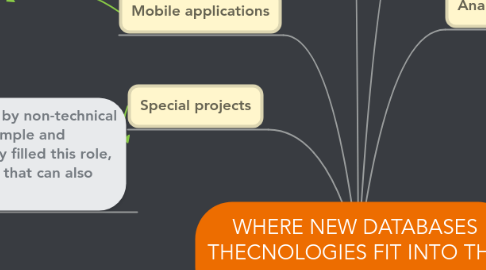WHERE NEW DATABASES THECNOLOGIES FIT INTO THE ENTERPRICE
by daniel jurado

1. Special projects
2. Security and compliance
3. Real-time or sub-second processing and response requirements
4. For lowlatency requirements, such as sensitive financial applications, enterprises are turning to in-memory databases, in which data is sent to random access memory spaces of PCs or servers. In addition, NoSQL databases offer the speed often required for real-time data streaming.
5. As with IT operational data, IT professionals need databases they can quickly call up and deploy. Here, cloud databases are a good match. Or, for developers seeking to work with cloud or service-oriented protocols such as REST and JSON, simple fast database types such as NoSQL document databases and key value stores may be most suitable.
6. For the management and storage of security data, such as passwords, encryption keys and user privilege information, enterprise administrators and developers need rocksolid secure databases. Relational database management systems have the secure environments built in that can manage these sensitive documents.
7. Many projects taking place around enterprises are typically led by non-technical business managers and professionals, and thus need to be as simple and intuitive to use as possible. Microsoft Access databases typically filled this role, but lately, there have been a number of cloud-based databases that can also fulfill this role.
8. Developer resources (configuration information)
9. Web applications
10. Remote devices—such as kiosks, sensors, or point of sale terminals—require databases that can run remotely, require little maintenance, are highly secure, and are untethered to a central data environment.
11. This is the great frontier of data, as more and more local client-side computing is now occurring through smartphones and tablets. As with embedded devices, mobile smartphones require databases that are capable of going offline, then syncing back up with a central database as needed.
12. Embedded devices and applications
13. Mobile applications
14. One of the hallmarks of big data is the amount of unstructured, user- and machine-generated information now being generated. For the most part, this data is beyond the reach of the relational database engines at the core of enterprises. These files are more manageable and accessible through file systems such as Hadoop, then stored within NoSQL databases
15. Unstructured data analytics
16. Core business functions and enterprise transaction processing
17. Analytics and business intelligence
18. IT operational data (logs, systems monitoring)
19. IT professionals need databases they can quickly spin up while they are in the midst of writing, testing or deploying code. For these purposes, they do not want to function as accidental DBAs—they need lightweight, quickly displayable databases. In times gone by, Microsoft Excel spreadsheets or Access databases served this role. NoSQL databases, particularly key value stores, are simple and rapidly deployable.
20. When it comes to analytics, the choice of database environment depends on the type of work being performed. Much of the unstructured data that comprises many analytics applications often reside within big data file systems, such as Hadoop. Thus, there’s an important role for NoSQL databases in these environments. However, for more traditional analytics that involve many popular desktop tools, then wellconstructed relational database or data warehouse environments fill the bill.
21. Thisis where the relational database still rules.Basic enterprise functions—payments,billing, tracking receipts, deliverables and payables—are best handled in industrialclass databases built to interface withall core enterprise applications. The relational database or data warehouse—built on ETL methodologies through which data is derived and filtered from specific source systems—is still the best bet.
22. NoSQL key-value store databases, in conjunction with back-end relational databases for payment transaction processing, are an effective combination. Another consideration, however, is the unpredictable spikes in traffic (outside of the November-December holiday season) that ecommerce sites typically encounter. A cloud-based database has the instantaneous ability require d in such scenarios.
23. Web applications generate a lot of session information, and for this purpose, NoSQL key-value databases may be the best bet, since they are simple and fast, operating close to internet time and quickly handling spikes in usage.
24. Ecommerce applications
25. Testing and pilot projects
26. Branch offices typically require smallfootprint databases that synch up with a central data environment, or, conversely, access via the network to a central database. As a branch location is likely to be transaction-focused, relational database management systems may be most effective here. However, if there are multiple branches opening in various parts of the globe, a cloud database may be needed to support access.
27. Peripheral/branch office suppor
28. As with IT operational data, IT professionals need databases they can quickly call up and deploy. Here, cloud databases are a good match, with as much capacity as needed readily available.


